On this page
- What is this information about?
- What is an Achilles tendon rupture?
- How long is it likely to take for my injury to heal?
- Will smoking or vaping slow down my healing?
- What should I do if I am in pain after my Achilles tendon rupture?
- What should I do if I have a swollen after my ankle tendon rupture?
- Can I walk after my Achilles tendon rupture?
- When do I need to wear the boot?
- What would happen if I stretched my calf?
- Why do I need to take the enoxaparin injections?
- How long will I need to use the blood thinners injections?
- How do I administer the injections?
- How do I dispose of the syringes?
- Will I have further (follow up) appointments?
- What should I be doing in the first six weeks after my injury?
- What exercise can I do to maintain my general physical strength?
- What do I do if I am struggling with my boot?
- I am diabetic, does this change things?
- What other things can the Virtual Fracture Clinic help me with?
- When can I start driving?
- How can I get a certificate to say that I am fit for work?
- Who do I contact about pain relief?
- When can I return to my sport?
- What do I do with my ankle boot when I no longer need them?
- How do I contact the Virtual Fracture Clinic?
What is this information about?
This information is about Achilles tendon rupture.
It tells you:
- how to look after yourself when you go home from hospital with an Achilles tendon rupture
- how to give yourself blood thinner injections, and why you need them
- how to wear the boot and wedges that have been given to you to support your foot
- what exercises you can do to help heal and strengthen your ankle
- who to contact if you need further help and support.
What is an Achilles tendon rupture?
An Achilles tendon rupture is a tear of the tendon that connects your calf muscles to your heel bone. Achilles tendon rupture is a common injury that usually happens while playing sport or doing exercise.
How long is it likely to take for my injury to heal?
It usually takes around twelve weeks to heal. It can take 12 months before you are ready to take part in high level sports and activities.
Will smoking or vaping slow down my healing?
Yes. Smoking slows healing so if you smoke or vape try to stop or cut down. This is most important in the first 2 weeks after your injury. If you would like help to stop smoking talk to your GP or visit Quit smoking – NHS for further information.
What should I do if I am in pain after my Achilles tendon rupture?
You may have ankle pain after your injury. If you are in pain, take your usual pain killers or pain killers given to you in the emergency department. Follow the dose instructions on the packet. If you are struggling with pain do speak to your GP or pharmacist.
Pain levels tend to go down over the first six weeks.
What should I do if I have a swollen after my ankle tendon rupture?
You may have ankle pain and swelling for three to six months after your injury. Swelling is often worse at the end of the day. The tendon may feel thicker or have a lump as it heals. To reduce swelling:
- try to rest your ankle, especially in the first 24-72 hours (one to three days)
- raise your ankle on a stool or cushions so that it is above the level of your hip.
Can I walk after my Achilles tendon rupture?
Yes. You can walk weight bearing in the boot (with wedges fitted inside the boot) as pain allows. You will not do any further damage to your Achilles tendon by putting weight on your foot if you are wearing the boot.
You may find crutches useful to help take some of the weight off your ankle in the early stage.
When do I need to wear the boot?
You must use the boot with wedges all the time, day and night. You are allowed to take off the boot briefly, once a day to change your sock and clean your foot. The wedges should sit under the insole (see images below). See information below about when to remove the wedges.
What would happen if I stretched my calf?
Avoid any temptation to stretch the calf as this could mean the tendon heals in a long position. This could mean your foot will not work as well in the future.
Why do I need to take the enoxaparin injections?
Your injury means you are at risk of developing a deep vein thrombosis (blood clot) which could potentially have serious effects.
To reduce this risk, we have given you enoxaparin (a type of blood thinner) injections, for six weeks.
How long will I need to use the blood thinners injections?
You need to use the injections daily for the first six weeks to help reduce the risk of deep vein thrombosis (blood clot) in your leg.
How do I administer the injections?
You will be shown how to administer the injection at the A&E, before you do the injections yourself. Your family members or a friend can help you.
You must do these injections at the same time of day. If you have a reaction to the medication, please contact your GP or 111.
How do I dispose of the syringes?
The used syringes and needles MUST be disposed of safely in the yellow sharps bin provided.
Once full, contact your local council who will arrange for it to be disposed of and get a new one for you.
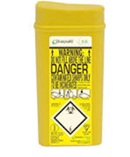
Will I have further (follow up) appointments?
Yes, you will have a follow up appointment with the physiotherapist in about ten weeks.
You will have another follow up appointment with the orthopaedic consultant in about six months’ time.
You will be sent an appointment time and date by post, or you will be given a call if it is close to the appointment date.
If you are:
- concerned about your symptoms
- unable to follow this rehabilitation plan before you are seen by the physiotherapist
please contact the Virtual Fracture Clinic team for further advice.
What should I be doing in the first six weeks after my injury?
- Keep the boot and all wedges on day and night for five weeks.
- Remove the boot briefly for washing and changing your sock once a day. When your boot is off, keep the toes pointed down.
- Start by taking off the wedges from the bottom of the stack from week five as described below.
- Use your blood thinner injections daily for six weeks.
If you feel the boot is rubbing or causing any problems with your skin, please contact the virtual fracture clinic.
Week 1:
Wear the boot and all the wedges all the time for the first full 4 weeks.
Week 5:
- At the start of week 5, take out one wedge from the bottom of the stack.
- Put the rest of the wedges back under the insole of the boot.
- Keep wearing the boot and the rest of the wedges all the time.
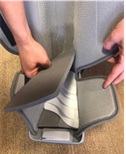
Week 6:
- At the start of week 6, take out another wedge from the bottom.
- Keeping wearing the boot and the remaining 3 wedges all day, but you can take off the boot at night.
- You should stop the enoxaparin injections at the end of week 6.

Week 7:
- At the start of week 7, take out another wedge from the bottom.
- Wear the boot and the remaining 2 wedges in the day.
Week 8:
- At the start of week 8, take out another wedge from the bottom.
- Wear the boot and the last wedge all day.

Week 9:
At the start of week 9, take out the last wedge and wear the boot whenever you are walking.
Week 10:
At the start of week 10 you can use your normal footwear.
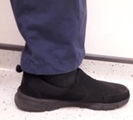
You can walk normally, but wait till your physio appointment for further guidance on return to any sports or activities.
What exercise can I do to maintain my general physical strength?
You can keep some leg strength through walking and by doing the exercises below.
Do 10 repetitions and 3 sets of each exercise daily. Hold onto a firm support in a safe space (for example where you cannot fall onto furniture with hard edges).
Hip flexion
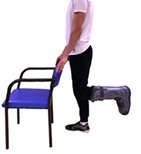

Hip extension
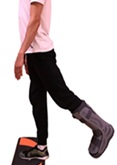

What do I do if I am struggling with my boot?
Adjusting the air support or elevating the foot may help. Using a higher soled shoe on the other foot can help with walking. You may also need a stick or crutch.
You should monitor your skin condition for any areas of redness or problems with your skin. Contact the Virtual Fracture Clinic Team if you are worried about this.
I am diabetic, does this change things?
Yes, you should have been given a different information sheet. Please contact the Virtual Fracture Clinic.
What other things can the Virtual Fracture Clinic help me with?
Please contact the Virtual Fracture Clinic if you:
- are concerned about your symptoms
- are struggling to return to exercise or your usual activities
- would like further information or support after you have read this information.
When can I start driving?
You can return to driving when:
- you are no longer using your boot
- you can walk comfortably
- you can safely deal with all emergency situations without being in pain or hesitating. for example, you must be able to stop the car quickly and in full control and safely avoid obstacles
- you are covered by your insurance company.
This is normally about week 12.
Be aware
always test your ability to drive in a safe environment first.
How can I get a certificate to say that I am fit for work?
You can get a fitness for work statement from the Virtual Fracture Clinic.
Who do I contact about pain relief?
Contact your GP if you have questions about medication or need more pain relief.
When can I return to my sport?
For the first 10 weeks avoid all exercise using your injured leg except walking and the exercises in this information sheet. Return to high level sport can take as long as 12 months. You can get more advice from your physiotherapist.
What do I do with my ankle boot when I no longer need them?
Do not return boots to the hospital. We are unable to reuse them.
How do I contact the Virtual Fracture Clinic?
Virtual Fracture Clinic
Working hours: Monday to Friday 8.30am to 4.30pm.
We aim to respond to messages within 24 hours during these times. At times you may receive a call outside of these hours.
Worthing Hospital
01903 205111
Ext. 86312
St Richards
01243 788122
Ext. 35503
This leaflet is intended for patients receiving care in St Richard’s and Worthing.
The information in this leaflet is for guidance purposes only and is in no way intended to replace professional clinical advice by a qualified practitioner.
Today’s research is tomorrow’s treatments. That’s why UHSx is proud to be a research-active Trust. Find out how you can get involved.
Visit our website www.uhsussex.nhs.uk/research-and-innovation/information-for-patients-and-public or scan the QR code: